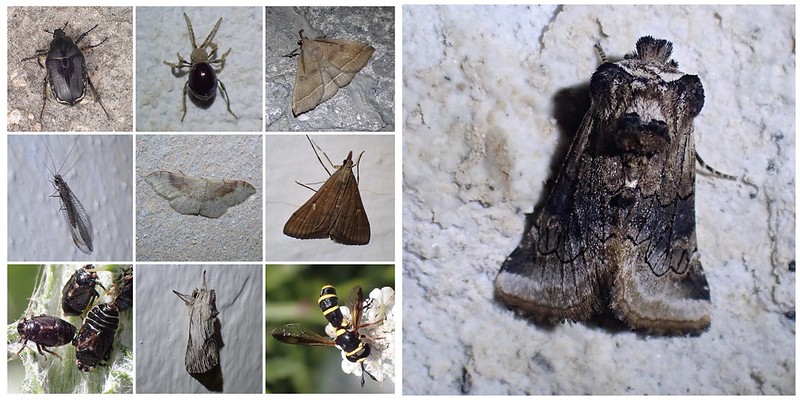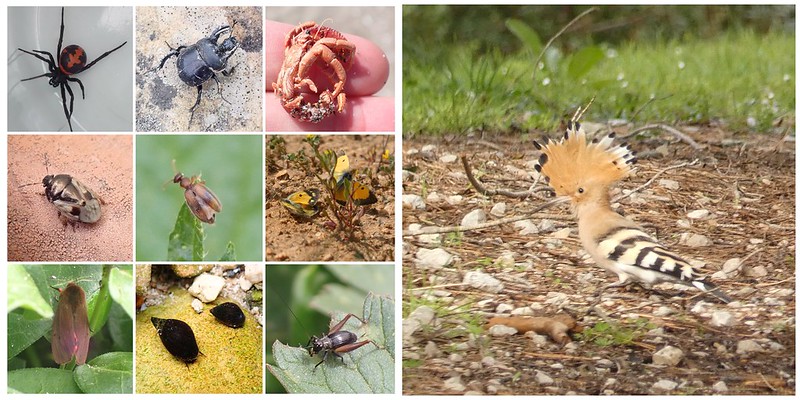iNat Year 2024 - goals and monthly recaps (-May)
So I have decided on this year's iNaturalist goals.
- First and foremost continue my streak which started on 30th Dec 2020. Since I don't work so much and I also don't have any international flights scheduled, it's just a matter of perseverance. If I don't find time during the day, I can always do my nightly moth-walk of about 1,5 h.
- Make a photo book at the end of the year. I started this in 2014 and it's growing into a nice collection. For that I should find at least 100 new-for-me animal species. Or at least 100 which haven't been featured in another book. Since the book of 2022 is about 2 months house-sitting in France (150 species) and 2023 about 3 weeks travelling the length of Germany (150 species, on which I am still working), there are quite a lot that don't yet appear in any book.
- I would really like to find 100 species of animals on thistles, from snails munching on the leaves, to butterflies and bees on the flowers, beetles laying eggs into the stems, finches eating the seeds, spiders building their web between the leaves etc. If I will be able to identify the species of thistle, that's enough botany for me.
Secretly I am also counting the number of animal species seen in this year, since I didn't manage to find 1000 animals last year and only just made it over 1000 in total.
I just changed the order so that the new month is in the beginning.
May highlights

The animals in the grid on the left side are all lifers for me. I have changed the order a bit to make it more interesting looking. The micro-moth Cosmopterix pulchrimella (Cosmopterigidae) was found on the 4th in Antequera. On the night-walk of the 7th I saw the beetle Calosoma maderae (Carabidae). On the 12th I was very surprised to suddenly stand in front of this beautiful western black-eared wheatear Oenanthe hispanica (Muscicapidae) at the Torcal de Antequera. The night-walk of the 11th brought me an interesting fly Oxyaciura tibialis (Tephritidae). On the 24th I wanted to start my snorkeling-season, but the water was still rather cold. So I mainly stayed on the beach collecting some shells, like this Columbella rustica (Columbellidae). I was very excited to have found another tephrid fly on the 28th, similar but different: Aciura coryli (Tephritidae). It was sitting on an almond tree which was totally covered in honeydew. I saw a lot of interesting insects there, but most of them are not/ cannot be identified. On the 30th I photographed a colourful wasp, which could be identified as Ctenochares bicolorus (Ichneumonidae). The honeydew-tree brought me another cute little fly on the 25th: Trigonospila transvittata (Tachinidae). Finally I found a caterpillar on a fig-tree on the 30th, which turned out to be Choreutis nemorana (Choreutidae).
The insect on the right is not new, but belong to those that I have to see every year. It flies only for a few weeks in early summer, so I really made an effort to find it. It is the two-winged spoonwing Nemoptera bipennis (Nemopteridae).
I think I have by now covered a lot of the easy to find and/ or easy to identify species. Even though I saw a lot, the tally is (only) at 471 RG animal species.
April highlights

Those insects which could be titled "50 shades of grey" were all new for me in April. 7 of them I found during my nightly moth-walk, where I now have a fixed route with the best lit facades.
Aethiessa floralis (Scarabaeidae) was found in Fuente de Piedra on the 6th. During a moth-round on the 14th I spotted this tiny Shiny Spider Beetle Mezium affine (Ptinindae). The night of the 17th brought me this Plumed Fan-Foot Pechipogo plumigeralis (Erebidae). A lacewing that could be identified as Pseudomallada genei was found on the night of the 20th. On the 22nd I found a new member of the large genus of Idaea, the Portland Ribbon Wave Idaea degeneraria (Geometridae) and this Long-legged China-Mark Dolicharthria punctalis (Crambidae) (which I just realised is not new). On the next day I went to the local pine forest and saw the planthoppers Tettigometra impressifrons (Tettigometridae) on thistles! The night of the 26th brought me a "punkish" Antirhinum Brocade Calophasia platyptera (Noctuidae). On the 28th I went on a day-trip to Córdoba and included a bit of colour with this hoverfly Ceriana vespiformis (Syrphidae). The highlight of the month has to be the moth on the right, because it was not only new for me, but also an iNatFirst! Meanwhile there are two more observations by me and two by someone else, so it can't be that rare. Cleonymia pectinicornis (Noctuidae).
But I also have to show some nice birds.

The Whiskered Tern Chlidonias hybrida (Laridae) was seen in Fuente de Piedra. The next two photos show drakes trying to impress their females: White-headed Ducks Oxyura leucocephala from the Guadalhorce-mouth in Málaga and a pair of Marbled Ducks Marmaronetta angustirostris in Fuente de Piedra. The next two photos are herons - the Squacco Heron Ardeola ralloides is from Fuengirola and the Black-crowned Night Heron Nycticorax nycticorax from Córdoba. The woodchat shrike Lanius senator was seen in Málaga.
Spring started really slowly and we haven't reached "Spanish" temperatures yet. But I managed to reduce last month's backlog and am now at 388 RG animal species.
March highlights

Steatoda paykulliana (Theridiidae) is nothing new, but one of the nicest coloured and patterned individuals I have ever seen. I found it in Jimena de la Frontera in the kitchen sink and caught it in a cup. What a great start to the day! On the same day I found this Chelotrupes sp. (Geotrupidae), which has inspired me to start a project about "Beetles with horns". On the 15th I made a day trip to the coast, collected some shells and came across this dead hermit crab Dardanus arrosor (Diogenidae). The following day brought me two lifers in my patio Crocistethus waltlianus (Cydnidae) and Cordicomus instabilis (Anthicidae). On the next day I could observe this couple of the very common Colias croceus (Pieridae). You usually never see them with open wings, so for me the mating rejection was a really lucky occurrence! The last three pictures are lifers from a day trip to Loja (province Granada) on the 23rd. Phragmatobia fuliginosa (Erebidae), Melanopsis praemorsa (Melanopsidae) and Trigonidium cicindeloides (Trigonidiidae). The hoopoe Upupa epops (Upupidae) I observed for quite a while in Jimena de la Frontera, while it found some snacks on the floor. Then for just a moment, it raised its hood! Never seen before, I thought it had something to do with social behaviour but there was no one else. Maybe it was excited about the food or afraid about the vultures circling overhead - anyway a memorable experience!
The last week of March was characterised by more or less constant rain - very unusual for Andalusia and very unwelcome because it was Semana Santa and all processions had to be cancelled. I just managed to keep up my streak and achieved only 276 RG animal species until the 31st.
February highlights

Cassida deflorata (Chrysomelidae) as larva, pupa and adult - on thistle; Abrostola triplasia (Noctuidae) new for me in my hometown; on the 18th I went for a day trip to the Bay of Cádiz and saw Afruca tangeri West African Fiddler Crabs - they only occur on the Atlantic coast from West Africa to the Algarve; as well as Numenius arquata (Scolopacidae) and Phoenicopterus roseus (Phoenicopteridae), not new, but I don't often get a photo in flight. From 29.2. to 3.3. I stayed with a friend in Jimena de la Frontera (Cádiz province). On the first night I did a moth-walk and found this new Horisme scorteata (Geometridae). The Red-legged Partridge Alectoris rufa is also from the Bay of Cádiz.
The number of RG animal species until the end of February is 196.
January highlights
Perigune narbonea (Geometridae); gall of wasp Andricus quercustozae (Cynipidae); Cisticola juncidis (Cisticolidae) is not new, but I think a really cute photo; of Dicranopalpus caudatus (Phalangiidae)I have to show two photos, because I find the forked pedipalps really fascinating; Conostethus venustus (Miridae) on thistle :-); Deroceras reticulatum (Agriolimacidae); Menemerus taeniatus (Salticidae); Chesias rufata (Geometridae). All of those species I found walking around Antequera. The wigeon Mareca penelope (Anatidae) I spotted on a day trip to the Guadalhorce-mouth in Málaga. This day and another trip to Fuente de Piedra provided all of the usual avian suspects (except cranes) and this new duck.
The number of RG animals species for January is 103.






